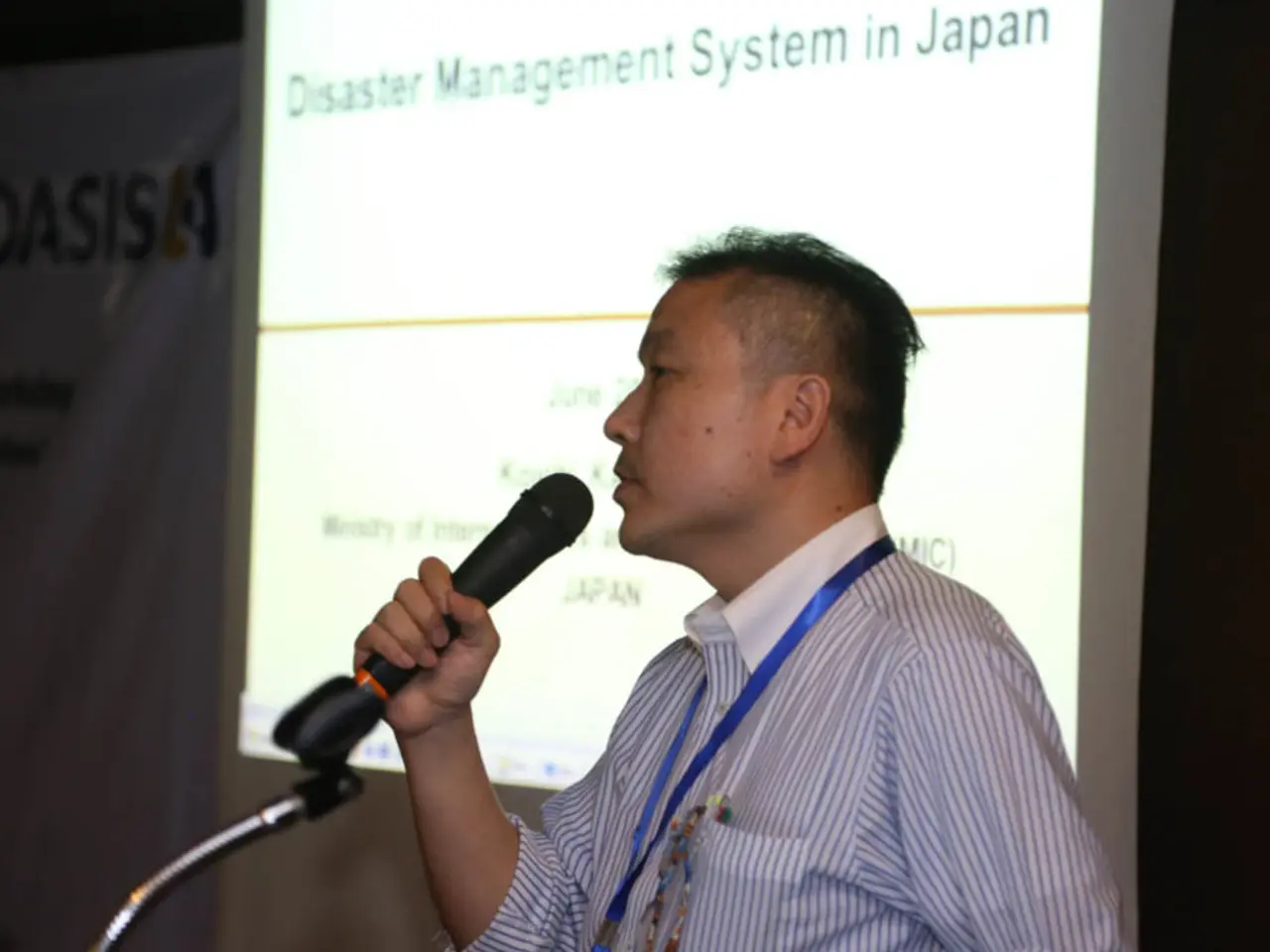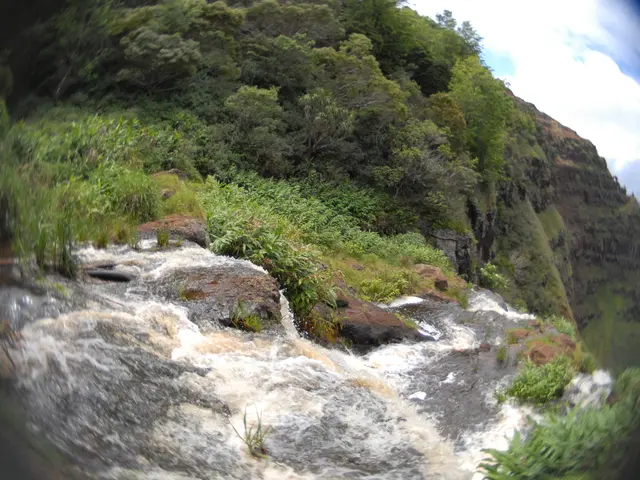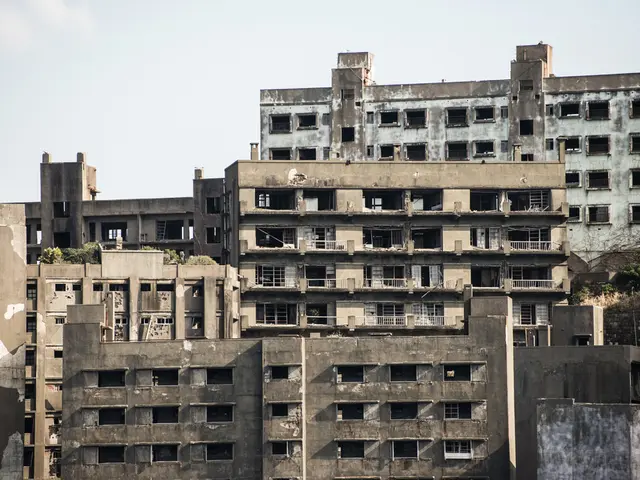Torrential downpours in southwestern Japan leave two presumed deceased and multiple individuals unaccounted for
Southwestern Japan has been hit by severe flooding and landslides since early August 2025, causing significant destruction and loss of life in several prefectures.
The hardest-hit region is the southern Kyushu island, where at least 6 deaths have been reported, around 5 people are still missing, and about 19 injuries have been recorded [1][3][4]. Among the affected prefectures are Kagoshima, Kumamoto, Miyazaki, Fukuoka, and others.
In Kagoshima, over 124,000 people have been displaced, with hundreds of houses flooded and evacuated [1][2]. Kumamoto, on the other hand, recorded up to 400 mm of rainfall in 24 hours, leading to severe landslides that have claimed lives and caused widespread infrastructure damage [3][4][5].
The city of Tamana in Kumamoto recorded 370 millimeters of rainfall in six hours through early Monday, nearly double the city's average precipitation for all of August [4]. Reports indicate that people have been swept away, and landslides have washed away houses and cars in Kumamoto and Fukuoka Prefectures [3].
Rescue operations are ongoing, with authorities searching for missing individuals trapped by mudslides or floodwaters. This includes a family caught in Kumamoto prefecture and others swept into rivers [3][5]. Evacuation orders and advisories have been issued for over 350,000 people across several prefectures.
Local firefighters have rescued 15 people stranded at a campsite in Kamiamakusa, while JR Kyushu suspended all bullet train services in the morning but resumed them in the afternoon [4][5].
The Japan Meteorological Agency issued a special heavy rain warning for parts of Kumamoto Prefecture, emphasizing the record rainfall event in some areas and the associated life-threatening danger. Officials have noted the increasing frequency of such heavy rainfall disasters due to climate change and the mountainous terrain heightening landslide risks [3][4].
Prime Minister Shigeru Ishiba has stated his government's commitment to implementing disaster response measures, urging residents to prioritize safety during ongoing adverse weather conditions [5].
In other news, a woman in her 30s was found dead in Aira, Kagoshima Prefecture, having been trapped in her house since a landslide on Friday. In Fukutsu, Fukuoka, two people in their 60s are still missing after being swept away by a river, and rescue operations are ongoing. Local police are confirming the identity of a man found nearby with no vital signs. A woman with no vital signs was also found inside a car that had fallen into an irrigation canal in Yatsushiro [1][3][4].
This devastating weather event serves as a reminder of the importance of disaster preparedness and the need for effective response measures in the face of climate change.
References:
[1] NHK World (2025). Heavy rain in southwestern Japan triggers evacuation orders, displaces thousands. Retrieved from https://www.nhk.or.jp/news/20250815_10232155.html
[2] Kyodo News (2025). Heavy rain in southwestern Japan prompts evacuation orders for thousands. Retrieved from https://english.kyodonews.net/news/2025/08/7c3565d3e6b4-heavy-rain-in-southwestern-japan-prompts-evacuation-orders-for-thousands.html
[3] The Asahi Shimbun (2025). Heavy rain in southwestern Japan causes floods, landslides, and evacuation orders. Retrieved from https://www.asahi.com/articles/ASH1M77942219.html
[4] Japan Today (2025). Heavy rain in southwestern Japan causes floods, landslides, and evacuation orders. Retrieved from https://japantoday.com/category/national/heavy-rain-in-southwestern-japan-causes-floods-landslides-and-evacuation-orders
[5] Mainichi Shimbun (2025). Heavy rain in southwestern Japan causes floods, landslides, and evacuation orders. Retrieved from https://mainichi.jp/english/articles/20250815/p2a/00m/0na/015000c
- Despite the general news focusing on the flooding and landslides in southwestern Japan, there have been reports of a car-accident associated with the heavy rain in Fukutsu, Fukuoka Prefecture.
- As the severe weather conditions continue to affect multiple prefectures, including Kagoshima and Kumamoto, there are growing concerns about potential fires igniting due to the ongoing sparks from downed power lines and other sources.
- While the focus remains on the ongoing rescue operations and response to the flooding and landslides, the Intergovernmental Panel on Climate Change (IPCC) has emphasized that such weather events are expected to become more frequent and intense due to global warming, underscoring the need for increased investment in AI technologies to improve disaster prediction and response efficiency in Japan.








